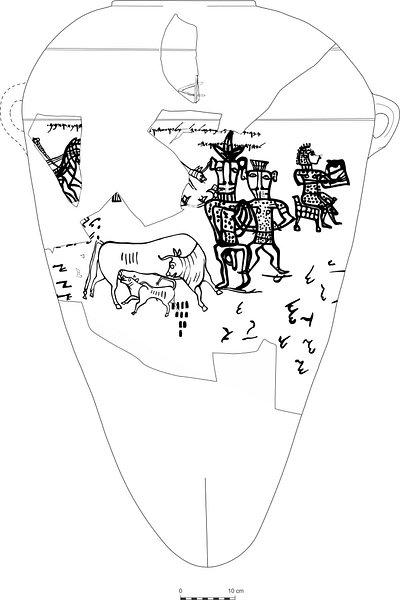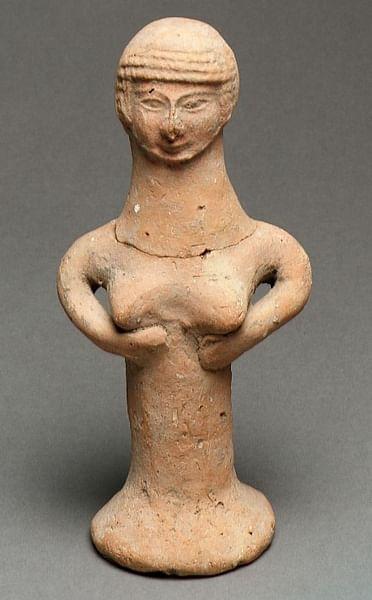Asherah is a Hebrew word for what was either a goddess or a cultic object or perhaps both. Although many see evidence for Asherah being an individual goddess known to the Israelites, some scholars believe that the context of the word primarily denotes it as a cultic object, as Mark Smith suggests in The Early History of God: Yahweh and the Other Deities in Ancient Israel, 2nd Edition. The Bible frequently addresses asherah (singular) and asherim (plural) as cult symbols from the time of the Israelite judges until right before the destruction of Judah in the early 6th century BCE. On the other hand, some passages in the Bible clearly reference Asherah as being a goddess. In the Bible, the Iron Age text of 1 Kings 18:19 states that Asherah had prophets in Tyre just as the Canaanite god Baal had prophets. Additionally, 2 Kings 23:6 declares that the priests of Solomon's Temple brought out “all the objects made for Baal and Asherah and all the host of heaven”. This verse also seems to indicate that Asherah was at least sometimes considered to be a deity.
Asherah & Other Deities
Asherah had not been found in any Iron Age Tyrian or Phoenician texts and so 1 Kings 18:19 might possibly hint that the Israelites associated Asherah with the Iron Age Phoenician goddess Astarte. In the Bronze Age, the Canaanite Asherah, known as Athirat, the wife of El and mother of the gods, was a principal deity in Tyre, and the connection of Asherah to the maternal goddess Astarte has been a long-standing theory among scholars. However, the specific name of Astarte is also found in the Bible, such as in Judges 2 and 1 Samuel 7; therefore, if there is a connection between Asherah and Astarte, they were also sometimes differentiated for reasons unknown.
Divine name changes and intercultural correlations are common in many ancient mythologies. Similarly, Asherah is often interlaced with various other deities of different names and is believed to have a diverse iconography. Her mythology is hard to determine because, in addition to Astarte, she often took on attributes of Anat and Ishtar-Inanna as well. In the Canaanite metropolis of Ugarit, she was known as Athirat, the wife of El and a mother goddess as the mother of the gods. Some scholars believe she was seen as early as the 2nd millennium BCE as a popular female deity in the Hittite culture. She may have also been associated with the goddess Elat. The Babylonian goddess Ashratu appears to be a version of Asherah, and she was known for her eroticism. The Babylonians learned of her through the Amorites who saw her as the consort of the god Amurru. In Babylon, she was thought to be the daughter-in-law of Anu and was known as the “lady of the steppes”. Her association with mountains in Babylon may be a hint to her Canaanite origins.
From Canaanite mythology, El's traditions and epithets were absorbed into the construct of the Israelite Yahweh, the God of the Hebrew Bible, and therefore it is likely that they acclimated Athirat/Asherah as well. Archaeological evidence for this can be found in the 8th-century BCE Kuntillet Ajrud inscriptions, found in the northeast part of the Sinai Peninsula. These inscriptions are written in Hebrew and translate as 'Yahweh and his Asherah'. Asherah is also associated with Yahweh in a similar possessive sentence in the 8th-century BCE Khirbet el-Qom inscriptions, found in the West Bank.
Goddess or Cultic Object
There is a debate as to whether these inscriptions refer to Asherah the goddess or an asherah as cultic object. One reason for the debate is that in the Kuntillet Ajrud and Khirbet el-Qom inscriptions pronominal suffixes show Yahweh having possession of the noun “asherah”, implying that this was an object. Ancient Hebrew did not use pronominal suffixes on proper nouns such as people or deities; however, other Semitic languages closely related to Hebrew did use such suffixes. Later in Israelite Deuteronomic tradition, Asherah and all deities other than Yahweh were strictly prohibited. Condemnations of Asherah appear to have been written in the 8th century BCE or later, cropping up at the same time as the Kuntillet Ajrud and Khirbet el-Qom inscriptions.

When not implying a goddess, the terms asherah/asherim in the Bible refer to cultic objects which were wooden poles, images, or trees associated with pagan worship and were supposed to have been destroyed by the Israelites. The verbs connected with asherah/asherim in the Bible are words often associated with wood, such as “fell”, “smash”, and “burn by fire.” It is possible that the asherim were originally living trees from which the wooden pole developed as a symbol of asherah to be placed beside an altar. In extra-biblical contexts as well, the goddess Asherah was often represented as a stylized sacred tree.
In the Bible, there appears to be a functional difference in the singular and plural forms of the word, with the singular being set up by altars and the plural in association with trees in high places. The following two verses demonstrate the distinction. Deuteronomy 16:21 commands:
You shall not plant any tree as a sacred pole [asherah] beside the altar that you make for the Lord your God…
And 1 Kings 14:23 states:
For they also built for themselves high places, pillars, and sacred poles [asherim] on every high hill and under every green tree…
These are just two examples out of several which consistently relate separate locations for the singular and plural forms. One theory proposed by J. R. Engle is that the plural asherim were associated with Judean pillar figurines while the singular asherah was a wooden pole. Although it is an interesting and often accepted theory, there is nothing in the biblical text that implies the asherim were clay figures. However, along with the disappearance of the Judean pillar figurines from the archaeological record, so did the Asherah cult disappear from Judean sites after the Babylonian Exile.
Conclusion
As possible evidence for Asherah being primarily a symbol rather than a goddess, there are no personal names found in stories or genealogies associated with Asherah, unlike names associated with El, Yahweh, and Baal. Due to the lack of evidence in the Bible and in archaeology for Asherah being a goddess in Israel (not just a symbol), it seems that perhaps the stylized tree and wooden pole representations remained after the original belief in the supernatural entity behind them faded, possibly as symbols of fertility. Some scholars, including G. Boström, H. Ringgren, and W.F. Albright, believed that the female representation for wisdom and the tree of life in biblical Wisdom literature may have sprouted from the remnants of an Asherah tradition.
